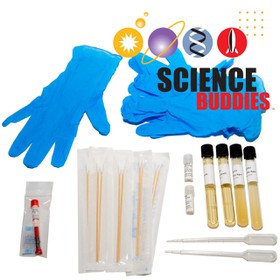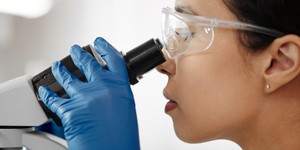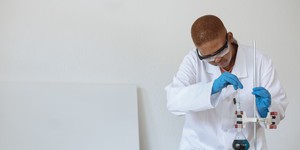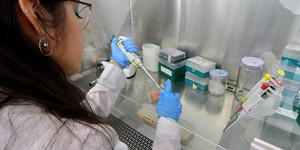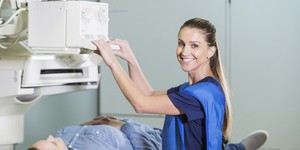Abstract
Ultraviolet light can damage DNA molecules. If a cell's DNA repair mechanisms can't keep up with the damage, mutations are the result. As harmful mutations accumulate, the cell eventually dies. How much ultraviolet light is too much for a bacterial cell?Summary
Andrew Olson, Ph.D., Science Buddies
Sources
This project is based on:
- Beck, A.E., 2004. What Are the Effects of Ultraviolet Light on Bacteria Mortality? California State Science Fair Abstract. Retrieved September 18, 2006.
Recommended Project Supplies
Objective
The purpose of this project is to observe the effects of short-term ultraviolet light exposure on bacteria.
Introduction
Ultraviolet (UV) light is invisible to our eyes, and has higher energy than visible light. "When considering the effect of UV radiation on human health and the environment, the range of UV wavelengths is often subdivided into UVA (400–315 nm), also called Long Wave or 'black light'; UVB (315–280 nm), also called Medium Wave; and UVC (< 280 nm), also called Short Wave or 'germicidal'." (Wikipedia, 2006a) Short-wavelength UV light has enough energy to damage chemical bonds in DNA molecules, which are very stable under most conditions.
"Ultraviolet light is absorbed by a double bond in pyrimidine bases (such as thymine and cytosine in DNA), opening the bond and allowing it to react with neighboring molecules. If it is next to a second pyrimidine base, the UV-modified base forms direct covalent bonds with it. The most common reaction forms two new bonds between the neighboring bases, forming a tight four-membered ring (see Figure 1). Other times, a single bond forms between two carbon atoms on the rings, forming a '6-4 photoproduct.' These reactions are quite common: each cell in the skin might experience 50-100 reactions during every second of sunlight exposure." (Goodsell, 2001)
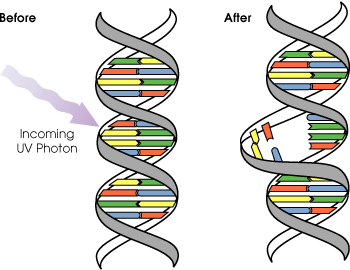
Figure 1. Short wavelength UV light can cause adjacent pyrimidine bases in DNA (thymine and cytosine), to bond to one another instead of the complementary DNA strand. This disrupts DNA replication.
Cells have mechanisms to repair this damage, but if the duration of exposure to UV light is sufficient, the repair mechanisms are unable to keep up with the rate of DNA modification. Short wavelength UV light can thus serve as a germicide.
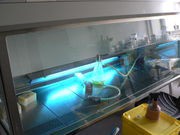
Figure 2. Short wavelength UV lights are often used to prevent microbial growth on work surfaces in tissue culture hoods, like this one.
In this project, you will determine how much UV light exposure is needed to kill bacteria in culture plates.
Terms and Concepts
To do this project, you should do research that enables you to understand the following terms and concepts:
- Ultraviolet (UV) light
- UVA
- UVB
- UVC
- DNA structure
- Pyrimidine
- DNA replication
Questions
- What are the differences between UVA, UVB, and UVC radiation?
- How does UV light damage DNA molecules?
Bibliography
This article discusses the chemical mechanism by which ultraviolet light causes damage to DNA molecules:
- Goodsell, D.S., 2001. "The Molecular Perspective: Ultraviolet Light and Pyrimidine Dimers," The Oncologist 6 (No. 3, June, 2001): 298-299. Retrieved December 11, 2018.
These Wikipedia articles discuss ultraviolet light and its use as a germicide:
- Wikipedia contributors, 2006a. Ultraviolet, Wikipedia, The Free Encyclopedia. Retrieved December 11, 2018.
- Wikipedia contributors, 2006b. Ultraviolet Germicidal Irradiation, Wikipedia, The Free Encyclopedia. Retrieved December 11, 2018.
Read and follow the UV safety precautions on this website:
- UC Davis Safety Services, 2017. Hazards of Ultraviolet Radiation, Safety Net, University of California at Davis. Retrieved December 11, 2018.
Materials and Equipment 
Recommended Project Supplies
- Neutralizing Bacteria Kit, available from our partner
Home Science Tools. Needed from the kit:
- Nutrient agar plates (15)
- E. coli culture, freeze dried and ready to reconstitute
- Sterile cotton swabs (5)
- Nitrile gloves
- You will also need to gather these items, not included in the kit:
- Permanent marker
- Safety glasses available on Amazon.com that offer UV protection, or a face shield with UV protection.
- Lab coat. Alternatively, old, long-sleeved protective clothing may be used instead.
- Short wavelength UV light. These are often called germicidal UV-C lights available on Amazon.com.
- Timer or clock that shows seconds
- 37°C incubator for bacterial culture plates. If this is not available, choose a warm location to keep the plates; the bacteria will grow slower and the experiment will take longer.
- Bleach
- Lab notebook
Disclaimer: Science Buddies participates in affiliate programs with Home Science Tools, Amazon.com, Carolina Biological, and Jameco Electronics. Proceeds from the affiliate programs help support Science Buddies, a 501(c)(3) public charity, and keep our resources free for everyone. Our top priority is student learning. If you have any comments (positive or negative) related to purchases you've made for science projects from recommendations on our site, please let us know. Write to us at scibuddy@sciencebuddies.org.
Experimental Procedure
For health and safety reasons, science fairs regulate what kinds of biological materials can be used in science fair projects. You should check with your science fair's Scientific Review Committee before starting this experiment to make sure your science fair project complies with all local rules. Many science fairs follow Regeneron International Science and Engineering Fair (ISEF) regulations. For more information, visit these Science Buddies pages: Project Involving Potentially Hazardous Biological Agents and Scientific Review Committee. You can also visit the webpage ISEF Rules & Guidelines directly.
This science fair project involves the use of the bacteria E. coli. While E. coli is not considered a biohazardous or dangerous bacteria, it is important to always properly clean and dispose of bacteria and supplies that come in contact with it. See the Bacterial Safety guidelines for more details on how to handle bacterial cleanup and waste.
Safety Note: Adult supervision is required for this project. Read and follow these Ultraviolet Light Safety Precautions (IBC UMN, 2003):
- The germicidal ultraviolet (UV) light used in this project will also damage unprotected human cells. Your eyes and skin are particularly susceptible to UV damage.
- Exposure to UV light can burn the retina or irritate the cornea and the conjunctiva. This can cause a feeling of "sand in the eye" and heightened sensitivity to light. Symptoms appear from 6 to 24 hours after exposure and usually disappear within 48 hours.
- Persons who have had the lens of an eye removed (e.g. cataract surgery) can receive permanent retinal damage from UV exposure - including blindness.
- Individuals who are exposed to photosensitizing agents (e.g. some oral drugs or topically applied creams) may not be aware of heightened sensitivity to UV radiation.
- UV radiation burns skin promoting skin aging and cancer.
- If possible, the UV source for irradiating bacterial cultures should be operated remotely, so that the Investigator is not exposed to UV light.
- If this is not possible, then the UV source should be set up so as to avoid direct exposure to the Investigator (i.e., placed behind a UV-blocking barrier).
- The Investigator should also use the following personal protective equipment:
- All skin should be protected including face, neck, hands, and arms.
- Wear gloves and long sleeves covering all skin above the gloves.
- Eyes and face should be protected by a face shield designed to block the UV wavelengths used. Radiation can readily reach the eyes through the open sides of standard eye glasses, so they do not provide sufficient protection.
- Follow the directions in the kit to reconstitute the dried E. coli. Let the reconstituted E. coli sit at room temperature for five minutes.
- Prepare 15 nutrient agar plates with the E. coli bacteria: while wearing gloves, gently shake the reconstituted vial of E. coli, add two drops of the bacterial suspension to a plate, use a sterile cotton swab to spread the bacteria around the entire plate. Cover the plate and wait 5 minutes for it to dry. Repeat for all 15 plates, using a fresh cotton swab every third plate.
- For the UV light exposure you will use the plates in five groups of three plates each. All plates should be at the same distance from the UV source. The table below shows the suggested UV exposure time for each group of plates. Remember to read and follow the UV light safety precautions (above) while performing this step.
- Just before exposing the plates to UV light, remove the lid of each of the plates. Protect half of each plate from UV light by using aluminum foil to cover half of the open plate. Make sure that the aluminum foil does not touch the nutrient agar.
| Group | UV light exposure time (seconds) |
|---|---|
| 1 | 15 |
| 2 | 30 |
| 3 | 60 |
| 4 | 120 |
| 5 | 300 |
- Immediately after the UV light exposure, put the lids back onto each of the plates. Use a permanent marker to indicate which half of each plate received UV light, and the duration of the exposure.
- Next, incubate the plates, inverted (lid down and agar-side up), overnight at 37°C (or longer if at lower temperature).
- Count colonies in both halves of each plate.
- For each group of plates, calculate the average and standard deviation of the number of colonies in each half of the plate.
- Make a graph showing the average number of colonies (y-axis) as a function of UV exposure time (x-axis).
- On the same graph, you can also use a different symbol to plot the average number of colonies on the unexposed (control) side of each plate.
- Is the average number of control colonies consistent across the five groups of plates? Why or why not?
- What duration of UV exposure results in 50% bacterial mortality? Are there any plates with 100% bacterial mortality? If so, what duration of UV exposure results in 100% bacterial mortality?
Bacterial Safety
Bacteria are all around us in our daily lives and the vast majority of them are not harmful. However, for maximum safety, all bacterial cultures should always be treated as potential hazards. This means that proper handling, cleanup, and disposal are necessary. Below are a few important safety reminders.
- Keep your nose and mouth away from tubes, pipettes, or other tools that come in contact with bacterial cultures, in order to avoid ingesting or inhaling any bacteria.
- Make sure to wash your hands thoroughly after handling bacteria.
- Proper Disposal of Bacterial Cultures
- Bacterial cultures, plates, and disposables that are used to manipulate the bacteria should be soaked in a 10% bleach solution (1 part bleach to 9 parts water) for 1–2 hours.
- Use caution when handling the bleach, as it can ruin your clothes if spilled, and any disinfectant can be harmful if splashed in your eyes.
- After bleach treatment is completed, these items can be placed in your normal household garbage.
- Cleaning Your Work Area
- At the end of your experiment, use a disinfectant, such as 70% ethanol, a 10% bleach solution, or a commercial antibacterial kitchen/bath cleaning solution, to thoroughly clean any surfaces you have used.
- Be aware of the possible hazards of disinfectants and use them carefully.
Ask an Expert
Global Connections
The United Nations Sustainable Development Goals (UNSDGs) are a blueprint to achieve a better and more sustainable future for all.
Variations
Be sure to follow the UV light safety precautions for all of these experiments.
- Are some bacterial strains more susceptible to UV-induced DNA damage? Are some bacterial strains less susceptible to UV-induced DNA damage? Do background research in order to develop a hypothesis, and then design an experiment to test it.
- Is UVB light an effective bactericide? Design an experiment to compare UVB exposure to UVC exposure. Make sure that you verify the range of wavelengths produced by each light source (see manufacturer's specifications).
- How good is sunblock at blocking UVB rays? Can it protect bacteria from germicidal illumination? You can use a protocol similar to the one here, but instead of using foil, spread a uniform layer of sunblock over half of the plate lid.
Careers
If you like this project, you might enjoy exploring these related careers:
Contact Us
If you have purchased a kit for this project from Science Buddies, we are pleased to answer your questions.In your email, please follow these instructions:
- What is your Science Buddies kit order number?
- Please describe how you need help as thoroughly as possible:
Examples
Good Question I'm trying to do Experimental Procedure step #5, "Scrape the insulation from the wire. . ." How do I know when I've scraped enough?
Good Question I'm at Experimental Procedure step #7, "Move the magnet back and forth . . ." and the LED is not lighting up.
Bad Question I don't understand the instructions. Help!
Good Question I am purchasing my materials. Can I substitute a 1N34 diode for the 1N25 diode called for in the material list?
Bad Question Can I use a different part?
Contact Us
Related Links
- Science Fair Project Guide
- Other Ideas Like This
- Microbiology Project Ideas
- My Favorites
- All About Agar
- Interpreting Plates
- Inoculation: How to Put the Bacteria You Desire on a Petri Dish
- Microbiology Techniques & Troubleshooting
- Microorganisms Safety Guide


